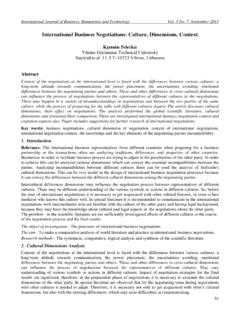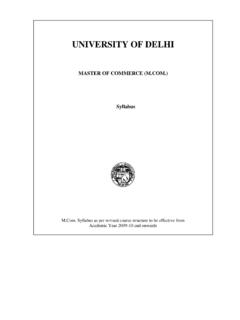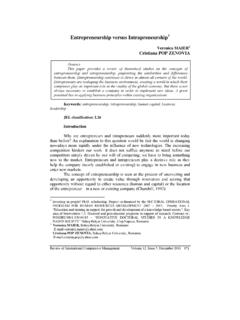Transcription of Strategic human resource management
1 Strategic human resource managementJohn BrattonChapter twoStrategic human resource management is the process of linking the human resource function with the Strategic objectives of the organization in order to improve performance. If a global company is to function successfully, strategies at different levels need to inter-relate. 1 An organization s [ human resource management ] policies and practices must fit with its strategyin its competitive environment and with the immediate business conditions that it faces. 2 The [ human resources business strategy] alignment cannot necessarily be characterized in the logical and sequential way suggested by some writers; rather, the design of an HR system is a complex and iterative process.
2 3 Chapter outlineChapter objectivesAfter studying this chapter, you should be able the meaning of Strategic management and give an overview of its the three levels of strategy formulation and comment on the links betweenbusiness strategy and human resource management (HRM) three models of human resources (HR) strategy: control, resource and on the various Strategic HRM themes of the HR performance link: re-engineering, leadership, work-based learning and trade some key aspects of international and comparative HRMI ntroduction management human resource management resource strategy models Strategic human resourcemanagement and models of humanresources strategy of Strategic humanresource management and comparative Strategic human resourcemanagement the first chapter, we examined the theoretical debate on the nature and significanceof the human resource management (HRM) model; in this chapter we explore anapproach to HRM labelled strategichuman resource management , or SHRM.
3 By astrategic approach to HRM, we are referring to a managerial process requiring humanresource (HR) policies and practices to be linked with the Strategic objectives of theorganization. Just as the term human resource management has been contested, sotoo has the notion of SHRM. One aspect for debate is the lack of conceptual clarity(Bamberger & Meshoulam, 2000). Do, for example, the related concepts of SHRM andHR strategyrelate to a process or an outcome? Over the past decade, HR researchers and practitioners have focused their attentionon other important questions. First, what determines whether an organization adoptsa Strategic approach to HRM, and how is HR strategy formulated?
4 Of interest is whichorganizations are most likely to adopt a Strategic approach to HRM. Is there, forexample, a positive association with a given set of external and internal characteristicsor contingencies and the adoption of SHRM? Another area of interest concerns thepolicies and practices making up different HR strategies. Is it possible to identify acluster or bundle of HR practices with different Strategic competitive models? Finally,much research productivity in recent years has been devoted to examining the rela-tionship between different clusters of HR practices and organizational HR strategy really matter?
5 For organizational practitioners who are looking forways to gain a competitive advantage, the implication of HR Strategic choices forcompany performance is certainly the key factor. Before, however, we look at some of the issues associated with the SHRM debate, weneed first to examine the Strategic management process. This chapter also examineswhether it is possible to speak of different models of HR strategy and the degree towhich these types of HR strategy systematically vary between organizations. We thenconsider some issues associated with SHRM, including international and comparativeSHRM. As for the question of whether there is a positive association between differentHR strategies and organizational performance, we are of the opinion that, given theimportance and volume of the research surrounding this issue, the topic warrants anextended discussion (Chapter 13).
6 In the current chapter, we address a number ofquestions, some essential to our understanding of how work organizations operate inthe early 21st century work and the role of HRM therein. How do big corporate deci-sions impact on HRM? Does the evidence suggest that firms adopting differentcompetitive strategies adopt different HR strategies? How does HRM impact on the bottom line ? There is a common theme running through this chapter, much of theHR research pointing out that there are fundamental structural constraints that attestto the complexity of implementing different HRM managementThe word strategy , deriving from the Greek noun strategus, meaning commander inchief , was first used in the English language in 1656.
7 The development and usage ofthe word suggests that it is composed of stratos(army) and agein(to lead). In amanagement context, the word strategy has now replaced the more traditionalterm long-term planning to denote a specific pattern of decisions and actions38 human resource ManagementModel of Strategic managementIn the descriptive and prescriptive management texts, Strategic management appearsas a cycle in which several activities follow and feed upon one another. The strategicmanagement process is typically broken down into five steps: undertaken by the upper echelon of the organization in order to accomplish perform-ance goals.
8 Wheelen and Hunger (1995, p. 3) define Strategic managementas that setof managerial decisions and actions that determines the long-run performance of acorporation . Hill and Jones (2001, p. 4) take a similar view when they define strategyas an action a company takes to attain superior performance . Strategic managementis considered to be a continuous activity that requires a constant adjustment of threemajor interdependent poles: the values of senior management , the environment, andthe resources available (Figure ). Strategic human resource management 39 Figure three traditional poles of a Strategic plan Source:Adapted from Aktouf (1996)ResourcesEnvironmentSenior managementHRM IN PRACTICE PLANNING HAS SUDDENLY GOT SEXYGORDON PITT.
9 THE INS AND OUTS OF management TOOLS. GLOBE AND MAIL, 1998, JANUARY 8In the past decade, the NorthAmerican workplace, as thosein Europe, has seen a constantparade of management fadsand fashions. In 1993, the topthree most popular manage-ment techniques were missionstatements, customer satisfac-tion measurement, and totalquality management . In 1996, Strategic planning, missionstatements and benchmarkingwere the top three managementtechniques. Of the 409 NorthAmerican companies surveyed,89 per cent reported using strate-gic planning in 1996. As onebusiness observer (Pitt, 1998)commented: Strategic planninghas always been around [but] itsuddenly got sexy.
10 And goals analysis formulation implementation evaluation. Figure illustrates how the five steps interact. At the corporate level, the strategicmanagement process includes activities that range from appraising the organization scurrent mission and goals to Strategic evaluation. The first step in the Strategic management model begins with senior managers eval-uating their position in relation to the organization s current mission and goals. Themission describes the organization s values and aspirations; it is the organization sraison d treand indicates the direction in which senior management is going.











